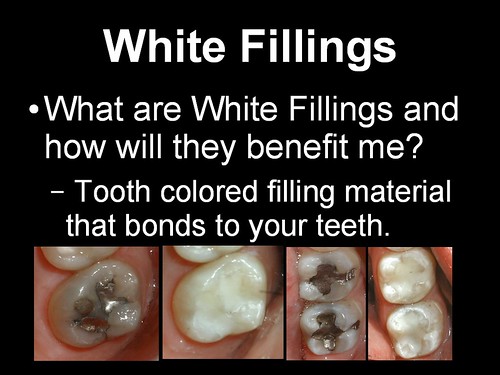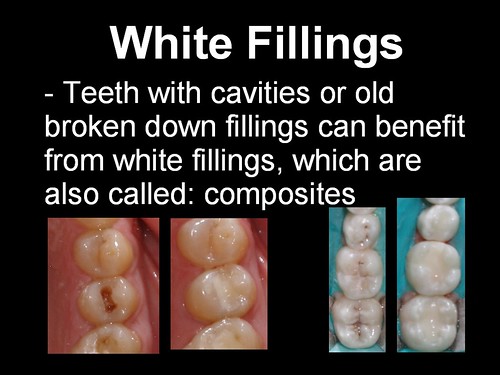

You have choices today when it comes to getting cavities in teeth filled. White fillings aren't new. In fact they've been around for a long time, but the technology used to chemically bond them to your teeth keeps improving all the time. The actually white filling material (composite resin) itself has also gotten stronger with advancements.
Many people think that they have done away with the old silver filling material - not true!
Here are some pros and cons to silver vs. white fillings:
White Fillings:
Advantage:
- looks like your tooth! - probably advantage #1, they really look GREAT!
- chemically bonds to the tooth to seal the filling in (silver fillings are just "packed in)
- repairable if some chips away because new material can stick to the old material
Disadvantage:
- not as strong as silver filling material (metal is still stronger than resin)
- more expensive than silver material (materials are more expensive, and they take longer to do)
- need an absolutely dry surface (no saliva or blood) to place the material for it to be successful. This can make using it very challenging on a lower tooth in the back of the mouth near the tongue, on an antsy child (or adult), or in other hard to reach areas.
- In an effort for dental insurance companies to reduce benefits (this is for BACK TEETH ONLY), if you select a white filling on a back tooth, many insurance companies will downgrade your benefit to a silver filling (because they are less expensive).
Example: The standard dental insurance pays 80% on regular fillings.
So let's say a White Fillings is $120 and a silver filling is $100
If you get a white filling, the insurance pays 80% of the $100 silver filling fee instead of on the $120 White Filling fee.
Your co-pay would be $20 on the silver filling, but would be $40 on the white filling.
Silver Fillings:
Advantage:
- less expensive
- faster procedure
- long lasting
- not as sensitive as white fillings are to moisture, meaning they can be placed easily on kids with active tongues, and hard to reach areas.
Disadvantage:
- doesn't look good
- does not bond to the teeth
- not easily repairable (usually needs total replacement)
- silver filling material still contains a small percentage of mercury. Some people will proclaim this is a problem, but this material has been around for a very very long time with a lot of positive results.
- the small percentage of mercury does allow the filling material to expand and contract (like mercury in a thermometer), which if a filling is large, can weaken the tooth over time. It seems like I see more broken teeth with large silver fillings in them than anything else.
No comments:
Post a Comment